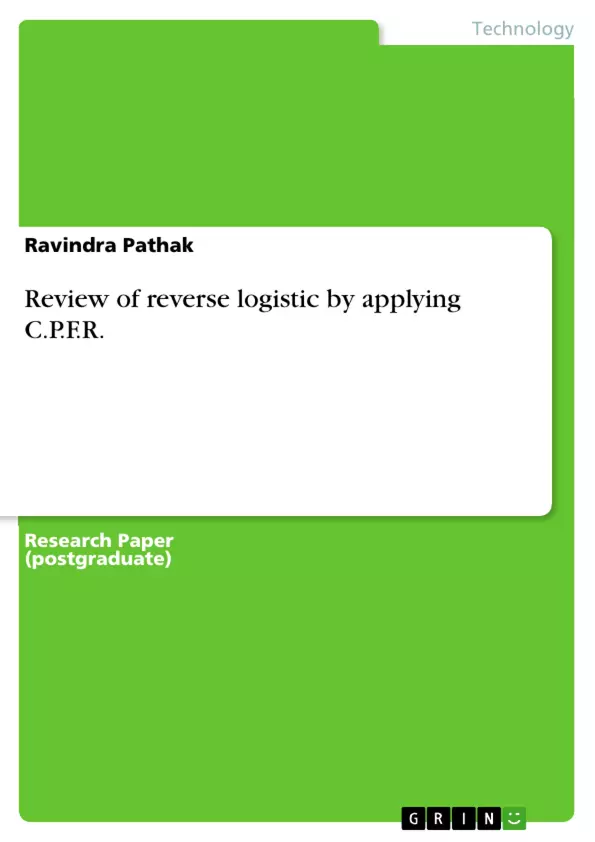
Review of reverse logistic by applying C.P.F.R.
Forschungsarbeit, 2007
7 Seiten
Leseprobe
Inhaltsverzeichnis (Table of Contents)
- Abstract
- INTRODUCTION
- Reverse Logistics is an important dimension of Supply Chain management.
- COLLABORATIVE PLANNING FORECASTING AND REPLENISHMENT
- NEED OF STUDY
- METHODOLOGIES AND CONCEPT.
Zielsetzung und Themenschwerpunkte (Objectives and Key Themes)
This paper aims to explore the role of Collaborative Planning Forecasting and Replenishment (CPFR) in optimizing reverse logistics, showcasing its effectiveness in creating an efficient system for product returns and recovery.
- The importance of reverse logistics in modern supply chain management
- The role of CPFR in enhancing reverse logistics operations
- The impact of CPFR on cost reduction and resource optimization in reverse logistics
- The application of CPFR to different stages of reverse logistics, including collection, inspection, reprocessing, and redistribution
- The potential benefits of a closed-loop supply chain design integrating forward and reverse logistics
Zusammenfassung der Kapitel (Chapter Summaries)
- Abstract: This section provides a brief overview of the paper, highlighting the importance of reverse logistics and the role of CPFR in optimizing it.
- INTRODUCTION: This section discusses the evolution of supply chain management, emphasizing the need for effective planning and management of resources. It also highlights the challenges of traditional supply chains, particularly in terms of inventory management and responding to changing customer demands.
- Reverse Logistics is an important dimension of Supply Chain management.: This section introduces the concept of reverse logistics, defining it as the process of planning, implementing, and controlling the flow of products from the point of consumption to the point of origin. It outlines the various benefits of reverse logistics, including asset utilization, recovery, profit maximization, environmental responsibility, and customer relationship management.
- COLLABORATIVE PLANNING FORECASTING AND REPLENISHMENT: This section introduces CPFR as a revolutionary tool in the logistics world, fueled by supply chain and collaboration tools. It highlights the potential of CPFR in providing better information for efficient resource planning and deployment by suppliers, manufacturers, and logistics service providers.
- NEED OF STUDY: This section delves into the four main processes of reverse logistics: collection, inspection/selection/sorting, reprocessing, and redistribution. It provides a brief overview of each process and its importance in the overall reverse logistics system.
- METHODOLOGIES AND CONCEPT.: This section emphasizes the strategic importance of logistics network design in conventional supply chains. It highlights the need to consider reverse logistics during network design, including aspects such as warehouse locations, plant capacities, vendor selection, distribution channels, and supporting technologies. The section introduces the concept of a closed-loop supply chain design, integrating forward and reverse logistics for optimal efficiency.
Schlüsselwörter (Keywords)
The key terms and concepts in this paper include reverse logistics, supply chain management, Collaborative Planning Forecasting and Replenishment (CPFR), closed-loop supply chain design, inventory management, customer relationship management, and asset utilization.
Details
- Titel
- Review of reverse logistic by applying C.P.F.R.
- Autor
- Ravindra Pathak (Autor:in)
- Erscheinungsjahr
- 2007
- Seiten
- 7
- Katalognummer
- V89891
- ISBN (eBook)
- 9783638041362
- Dateigröße
- 578 KB
- Sprache
- Englisch
- Schlagworte
- Review
- Produktsicherheit
- GRIN Publishing GmbH
- Preis (Ebook)
- US$ 6,99
- Arbeit zitieren
- Ravindra Pathak (Autor:in), 2007, Review of reverse logistic by applying C.P.F.R., München, Page::Imprint:: GRINVerlagOHG, https://www.diplomarbeiten24.de/document/89891
- Autor werden
- Ihre Optionen
- Vertriebskanäle
- Premium Services
- Autorenprofil
- Textarten und Formate
- Services für Verlage, Hochschulen, Unternehmen

- © GRIN Publishing GmbH.
- Alle Inhalte urheberrechtlich geschützt. Kopieren und verbreiten untersagt.
- info@grin.com
- AGB
- Open Publishing
Der GRIN Verlag hat sich seit 1998 auf die Veröffentlichung akademischer eBooks und Bücher spezialisiert. Der GRIN Verlag steht damit als erstes Unternehmen für User Generated Quality Content. Die Verlagsseiten GRIN.com, Hausarbeiten.de und Diplomarbeiten24 bieten für Hochschullehrer, Absolventen und Studenten die ideale Plattform, wissenschaftliche Texte wie Hausarbeiten, Referate, Bachelorarbeiten, Masterarbeiten, Diplomarbeiten, Dissertationen und wissenschaftliche Aufsätze einem breiten Publikum zu präsentieren.
Kostenfreie Veröffentlichung: Hausarbeit, Bachelorarbeit, Diplomarbeit, Dissertation, Masterarbeit, Interpretation oder Referat jetzt veröffentlichen!
- GRIN Verlag GmbH
-
- Nymphenburger Str. 86
- 80636
- Munich, Deutschland
- +49 89-550559-0
- +49 89-550559-10
- info@grin.com
-









